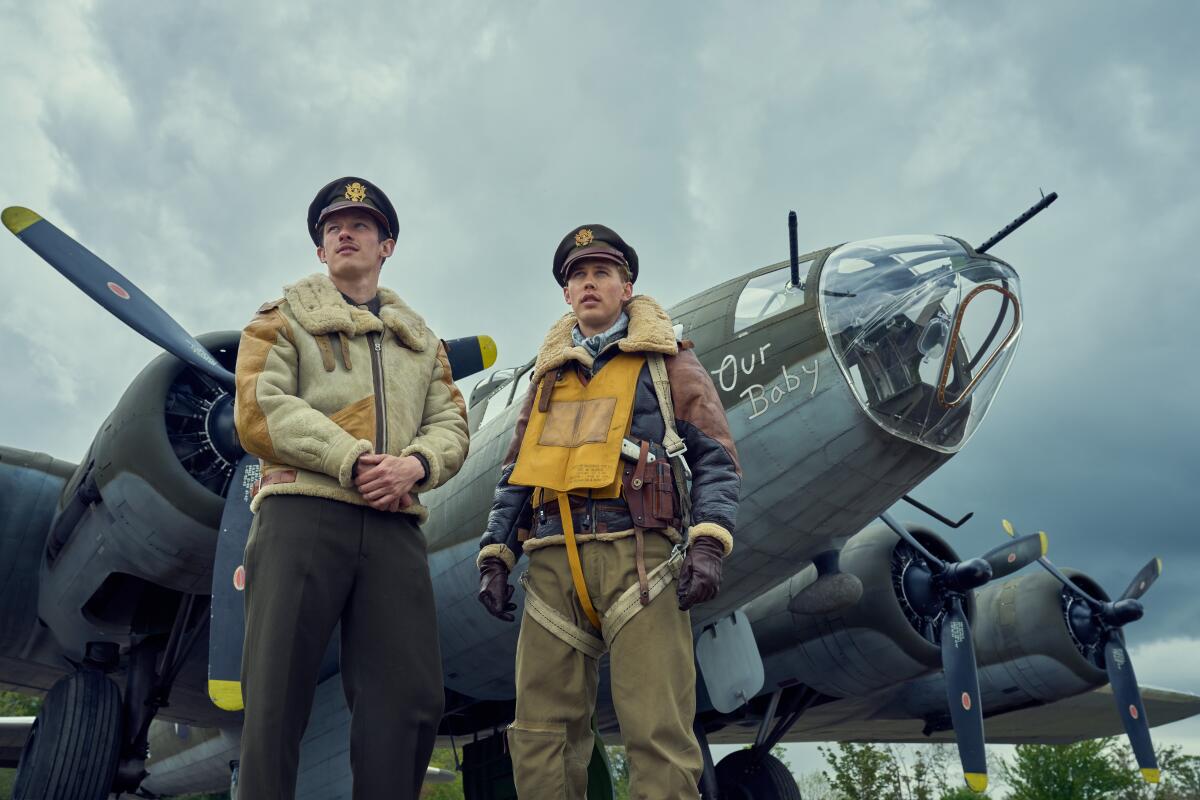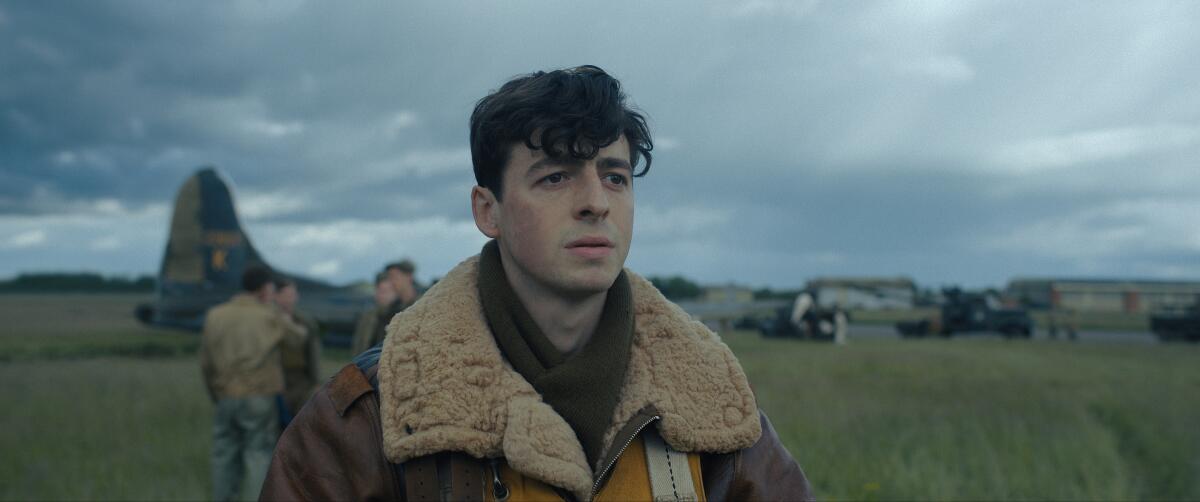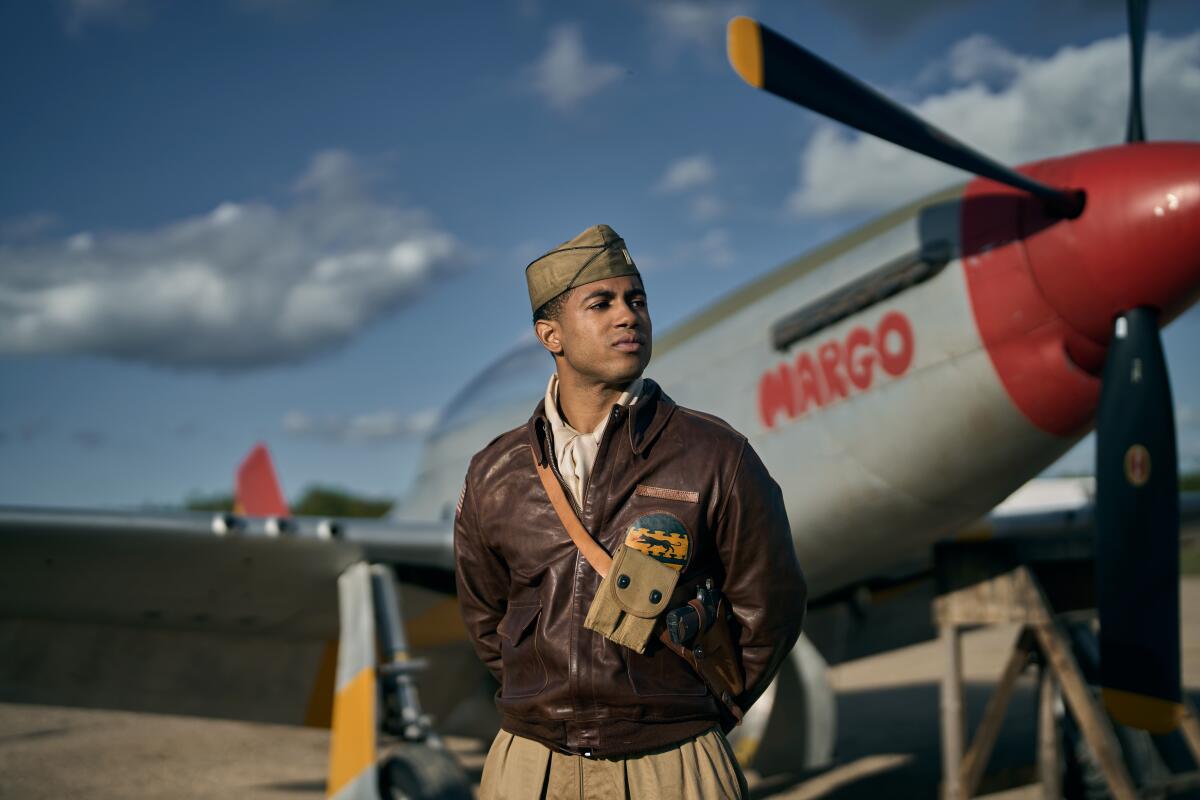‘Masters of the Air’ is a visually spectacular re-creation of war centered on real-life stories

- Share via
Completing a trilogy, until a subsequent miniseries about submarines or PT boats makes it a tetralogy, comes “Masters of the Air” (Apple TV+, Friday), which, like its predecessors “Band of Brothers” (2001) and “The Pacific” (2010) is based on a thoroughly researched work about real people and events, then dusted — at times slathered — with Hollywood magic.
It is meant on the one hand to achieve a high level of realism and on the other to echo the romanticism of the pre-revisionist World War II films that producers Steven Spielberg, Tom Hanks and Gary Goetzman would have grown up watching rerun on television. One would say it succeeds on both those accounts, even as they tend to fight one another. If you have ever wondered what it was like on the inside of a B-17 bomber as it is being torn apart by flak and Messerschmitts, this is your limited series; but you might wish they had turned down the music.
And on yet another hand, it is a salute to the few remaining survivors of that conflict, and by extension, to all American troops everywhere.
Donald L. Miller’s 2006 “Masters of the Air: America’s Bomber Boys Who Fought the Air War Against Nazi Germany” is the source, from which John Orloff (who wrote two episodes of “Band of Brothers”) has extracted as his subject the 100th Bomber Group of the Eighth Army Air Force, which flew missions into Northern Europe. They were known as the Bloody 100th, not for the casualties they inflicted, but for the casualties that were inflicted upon them; the chances of making it alive through a 25-mission tour of duty were estimated as 1 in 4 or 5.
If you watch until the end of the ninth and final episode, which is easy to do in terms of the filmmaking if often difficult in terms of the subject, you will find real-life images of its main characters — who are very much characters here, even as they were real people there. At the center of the story — to the extent there is a story and not just a series of events — are best friends Maj. Gale “Buck” Cleven (Austin Butler) and Maj. John “Bucky” Egan (Callum Turner), handsome, charismatic, expert pilots early described as “the unquestioned leaders of entire group.” (Though one wag observes, “If you ask me, those two watched ‘Test Pilot’ a few too many times.”)
Cleven, imperturbable yet not insensitive, doesn’t drink or gamble or dance — he’s a movie cowboy — and Egan is the opposite. (He’s the one with the mustache, naturally.) It is nice to see Butler freed from the mimesis of “Elvis” to create a more or less original character — based on an actual person, though not an actual person whom anyone watching is likely to have ever seen or heard — though it might take you a minute to shake the memory of that earlier performance, and pompadour, from your mind.

The other two major characters are Anthony Boyle as Maj. Harry Crosby, a navigator, who is the series’ occasional narrator; and Nate Mann as Maj. Robert “Rosie” Rosenthal, an extraordinary flier who is arguably the most renowned of the 100th veterans, and worth a biopic of his own — though he is somewhat less central here, as he’s more of a lone figure. A Jewish lawyer from Brooklyn, he’s used here as a sort of dramatic link to the Holocaust. (He was later on the team that prosecuted Nazi war criminals at Nuremberg.)
The late-series insertion into the story of the Tuskegee Airmen, who had nothing to do with the 100th but in their game-changing P-51 Mustang fighters did fly support missions for the bombers, introduces 2nd Lt. Alexander Jefferson (Branden Cook), whose historical destiny will be entwined ahistorically with some of major characters. If this interpolation exists merely to inform or remind audiences that Black soldiers flew combat missions in the war, that’s a good enough reason. Perhaps similarly, Bel Powley plays a British female officer Crosby gets to know who will not tell him anything about her job, which should tell you something about her job; and this invention seems in part designed to provide, in a series full to bursting with men, at least one woman with agency — and she has a lot of agency.
Other characters, whose names we will not catch or remember, some with mustaches, some without, appear for a moment or a while, but several actors make strong impressions just in passing. Many will, in any case, not be alive long enough to know, which is, after all, sort of a theme here.
As to the enemy, though we get a brief glimpse of the ruins Allied bombings made of German cities, and civilians, he is largely faceless — often literally, inside a fighter plane. Those soldiers we do see adhere to cliches, or utter them — “That is a Jewish name, yes?” — including the “civilized” interrogators who try to loosen up a captured flier with talk of baseball.

Like its predecessors, “Masters of the Air” focuses on the people doing the fighting rather than the brass whose decisions may not always be for the best or for the best reasons; indeed, the upper-echelon figures we do see tend to be wise and caring and ready to climb into the cockpit. (My introduction to World War II bomber squadrons was “Catch-22” — the book, not the movie or the miniseries — a much different take on military bureaucracy.) Unlike the soldiers of “Band of Brothers” and “The Pacific,” suffering on the ground, the characters here return every day from missions, if they do return, to the safety of England, where they may attend dances and flirt with Red Cross coffee servers.
Still, the trauma of serving in a unit where your chances of being killed far outweighed the alternative is duly noted. (“That’s the last ... time I’m going up. They can’t make me go up again,” cries one anonymous character, while narrator Crosby notes that “some of the men were coming undone.”) But since the series doesn’t actually follow any traumatized characters — only some slightly, temporarily conflicted ones — it’s easy enough, between combat scenes, to feel like everything’s fine. There are occasional philosophical ruminations on the bigger picture — Crosby quotes Nietzsche on being careful when you fight monsters because when you stare into the abyss long enough the abyss will stare back at you — but these usually end in support of the mission. (Proposition: “This war — human beings weren’t meant to behave this way.” Conclusion: “You see people being persecuted, subjugated, you have to do something, right?”)
Like “Band of Brothers” and “The Pacific,” “Masters of the Air” seeks to offer a representative array of situations within a sliver of a huge subject, and to tag all the relevant bases, if at times only for a conversation, or even a sentence; some terms of art — MIP, combat box — are thrown in without explanation (I approve of this practice), but if you pay attention, you will get a fair idea of how a B-17 works. But many things can also happen to a flier, including getting shot down and captured, and getting shot down and not captured, and we get pictures of both scenarios. Indeed, the series needs to get earthbound sometimes, if only for relief. At the same time, this inclusiveness can make the series feel a little wayward, a little fragmented at times; some side plots seem to bloom and evaporate before they’re quite done.
With a reported budget of $250 million more or less — you could make “Barbie” and “Oppenheimer” for that, or “The Holdovers” 10 times over — it is as spectacular as you’d expect. Spielberg doesn’t fool around. (And yet I was perhaps most excited by routine details: the ritual of checking that everything works before takeoff, the coffee and sandwiches offered fliers as they return from a flight to be debriefed — they felt authentic and informative.) At one point, I thought we were going to be treated to an episode focusing on the ground crew, which I would have watched happily. The series itself reminds you that you’re watching a production, and not a documentary, with movie moves — and, for all the scrupulousness of its re-creations, a Hollywood relation to history: Characters, whose actual accomplishments and adventures are related here, are also enlisted into situations in which they did not participate, simply for dramatic purposes. But if you’re not in the habit of interrogating a docudrama for accuracy, or happen to have read Miller’s book, this will probably not bother you.
And as the war ends — we win, not a spoiler — and the B-17s fly away home, the little children of the neighborhood, whom we have seen hanging around throughout, stand and salute, as the music swells with pride. It’s corny as Kansas in August, but I can’t say it didn’t move me.
More to Read
The complete guide to home viewing
Get Screen Gab for everything about the TV shows and streaming movies everyone’s talking about.
You may occasionally receive promotional content from the Los Angeles Times.







